
The state of the air we breathe has been called a ‘public health emergency’, and a ‘silent pandemic’, with children at particular risk. Every year, pollution causes up to 40,000 deaths in the UK and costs the country more than £20bn, according to the Royal College of Physicians.
The Government has three times been ordered by the courts to publish viable plans to tackle air pollution, and recently published a draft document, containing proposals which environmental lawyers have slammed as ‘weak and incoherent’. With the majority of environmental regulations emanating from Brussels, there are fears that Brexit will make matters worse.
Nurseries, which often need to be in the heart of their communities, as well as easily accessible to parents looking to drop children off on the way to work, can be particularly vulnerable to air pollution. Recent research from Greenpeace revealed more than 1,000 English nurseries are within 150m of a road where the level of nitrogen dioxide (NO2) from diesel traffic exceeds the legal limit of 40 micrograms per cubic metre of air. Previous studies found that a third of London’s state nurseries are in areas where toxic levels of NO2 threaten children’s health.
‘Unless they are playing right by the side of the road, children are not being continuously exposed to the levels being reported, unless it is summer and the windows are open,’ cautions Ian Colbeck, professor of environmental science at the University of Essex. ‘But that’s not to say pollution is not a problem for children. They get a bigger dose relative to their size when they breathe in – because of their age and the way they are developing, pollution has a bigger impact.’
Children are often used to breathing through their mouth, bypassing the natural defences of the nasal passages, and buggies and prams put them at the level of car exhausts.
REGIONAL VARIATIONS
Pollution is at its worst in London, which managed to breach annual limits just five days into 2017. London Mayor Sadiq Khan issued the capital’s first ‘very high’ pollution alert in January: some schools banned children from playing outdoors, and Public Health England warned Londoners to cut outside exercise. Poorer communities are often exposed at higher levels: 82 per cent of London schools in polluted areas are considered ‘deprived’, according to research commissioned by the Greater London Authority (GLA).
While Greenpeace’s research found the majority of nurseries close to polluted roads (760) are in the capital, pollution is not just an issue for Londoners. ‘Data shows the problem is much wider,’ says Areeba Hamid, clean air campaigner at Greenpeace. Outside of London, the local authority areas with the most nurseries in polluted areas are: Birmingham, Sandwell, Nottingham, Plymouth, Manchester, Leicester, Hampshire, Leeds, Wolverhampton and Salford.
The Midlands is one of the worst-hit areas, with Government figures revealing air pollution is responsible for 5.7 per cent of the deaths of over-25s every year. In 2015, Birmingham was one of five cities – alongside Leeds, Nottingham, Derby and Southampton – ordered to introduce a Clean Air Zone by 2020.
Traffic is the main contributor to air pollution, driven by emissions of particulate matter and nitrogen oxides from diesel vehicles.
‘It is clear that diesel vehicles are one of the largest contributors,’ says Ms Hamid. Research from King’s College London did find that the proliferation of wood-burning stoves is also contributing to rising pollution, and other sources include construction, building and shipping. ‘But compared to the proportion caused by diesel vehicles, this is quite a small amount,’ says Ms Hamid.
HEALTH MATTERS
Damage can start before birth: studies have found that when babies are exposed to air pollution in the womb, it can alter their lung development, as well as potentially leading to premature birth and low birth weight. According to the World Health Organization, children are particularly vulnerable to the effects of pollution when they have underlying chronic lung diseases such as cystic fibrosis and asthma, or heart problems. Children who are regularly exposed to tobacco smoke at home are also at greater risk of being affected by outdoor pollutants.
High exposure to polluted air at a young age has been linked to stunted lung growth, and scientists say living near roads travelled by 10,000 or more vehicles per day could be responsible for some 15 to 30 per cent of all new cases of asthma in children.
Wheezing, coughs and infection such as pneumonia are also more likely in polluted areas. Exposure to air pollution in childhood could also be linked to the development of lung cancer in adults.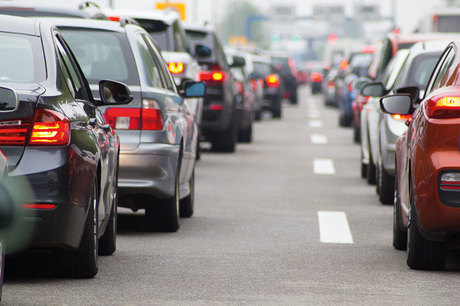
POTENTIAL SOLUTIONS
The Government’s latest clean air strategy proposes handing most of the responsibility for tackling pollution to local authorities. Measures could include fitting buses with more environmentally friendly technology, encouraging local transport operators to use ultra-low emission vehicles, providing adequate charge points to encourage public take-up of electric cars, and encouraging use of public transport, cycling, walking, park-and-ride and car-sharing.
While Clean Air Zones are encouraged, the Government does not want local authorities to charge any vehicles for entering them unless all other options have failed, which campaigners complain renders the proposal toothless.
Some local authorities are already taking their own measures to reduce pollution.
London’s Mayor intends to introduce an ‘ultra-low emissions zone’ in 2019, which aims to halve toxic emissions from diesel vehicles. He has also provided £250,000 to fund 50 air-quality audits at the worst-affected primary schools, many of which have nursery classes.
The money will fund measures which could include:
- moving entrances and play areas to reduce exposure to busy roads
- banning parked cars from keeping engines running
- minimising emissions from settings’ boilers and other sources
- a ban on the most-polluting vehicles near schools
- pedestrianising entrances
- creating ‘green infrastructure’ such as ‘barrier bushes’ to block out fumes
- encouraging walking and cycling through competitions, and ‘walking buses’.
PRACTITIONERS’ ROLE
- Early years practitioners may feel at a loss when confronted with pollution, with no power over the real changes that will prevent the problem. However, the National Day Nurseries Association (NDNA) has devised a list of positive steps that settings can take:
- Check local air pollution levels so you can plan accordingly (see More information).
- Reduce physical activity levels when air pollution is high, especially if children are experiencing symptoms such as coughs or sore throats.
- Avoid taking children on outings next to busy roads with lots of traffic.
- Ensure staff can recognise signs of respiratory distress and know how to deal with it.
- Consider using an indoor air purifier.
- Keep filters on air-conditioning units and keep heaters clean.
- Vacuum regularly.
- Open the windows to circulate the air on days when the air quality is good.
- Promote a good healthy diet with lots of fruit and vegetables.
Some nurseries have been lucky enough to receive local authority funding to tackle air pollution. Ready Steady Go in Camden was one of a number of settings that received a share of a £55,000 air-quality fund in 2013. The nursery used the local authority funding to encourage parents not to drive to the setting, constructing an outdoor covered pram and scooter store, as parents said the lack of one was a major barrier to walking to the nursery.
Early years consultant Linda Pound is governor at Robert Owen Nursery School in East Greenwich. ‘We have particular concerns about pollution – there’s the Blackwell Tunnel, a lot of construction work, and also there are plans to establish a cruise liner port on the river, which could increase pollution immensely,’ she says. ‘There is not much that nurseries can do, but they can advise parents to take relatively traffic-free routes, even if that means going a bit further.
‘The local authority runs “walk to school” schemes, which we take part in – a lot of children come to nursery on scooters,’ says Ruth Mercer, head at Robert Owen. ‘We don’t allow parents’ cars in our carparks, although that is as much to do with safety as cutting down on fumes. We also send a newsletter to parents once or twice a year looking at what’s happening in our area in terms of pollution.’
There is a difficult line between informing and frightening parents. ‘If settings talk too much about pollution, parents may get worried and look at moving their children somewhere else, but in fact a high percentage of settings are affected in London,’ says Ms Pound.
ADVISING AND CAMPAIGNING
Parents with buggies and prams could consider using covers, especially at pollution hotspots such as traffic intersections. ‘A number of infant schools have been recommending face masks, but the trouble is they don’t work,’ says Professor Colbeck. ‘They don’t filter out the particulates and they have to be fitted properly: the ones you buy for a couple of pounds don’t really do anything. If people are worried, there are cheap sensors you can buy which give an indication as to what the air quality is like.’
Nurseries can also get involved in local campaigns for free air. ‘When we released our research we wrote to the nurseries affected, and urged them to put pressure on their local MP to take action,’ says Ms Hamid. Children from Archbishop Sumner Church of England Primary School in Lambeth, which has a nursery class, took part in a recent Carnival for Clean Air, where they launched a children’s clean-air pledge. The children will use pollution monitors to measure levels of nitrogen dioxide as they walk to school. Treehouse Nursery, in Wanstead, north-east London, has been involved in a local campaign to stop buses running their engines when they are parked. Parents were given leaflets about the petition, and staff also taught children about the importance of air quality.
Campaigners make the point that settings shouldn’t have to take dramatic steps such as moving playgrounds and entrances to keep children safe. ‘These steps don’t solve the overall problem. We want to see a move away from diesel altogether, and better public transport,’ says Ms Hamid. But until bigger changes can be made in society, nurseries, parents and carers must do what they can to keep children safe.
CASE STUDY: ST LUKE’S CE PRIMARY SCHOOL, LONDON
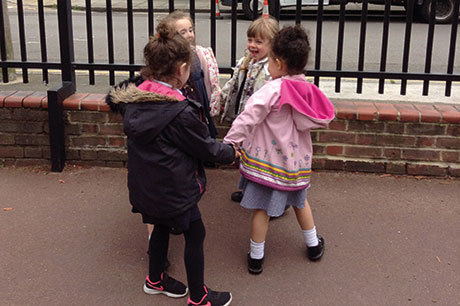 St Luke’s CE Primary School, in the heart of London’s Docklands, takes nursery children from the age of three and has seen a noticeable increase in chest-related health problems in the past few years.
St Luke’s CE Primary School, in the heart of London’s Docklands, takes nursery children from the age of three and has seen a noticeable increase in chest-related health problems in the past few years.
‘Our playground is very close to the road – it isn’t a major road but it can be very busy at certain times of the day,’ says Sue Hudson, nursery teacher. ‘We only have railings, so children can be exposed to fumes from cars parked outside, or driving past, or passers-by smoking. There have been a lot more children with asthma and allergies, or taking time off with chest infections.’
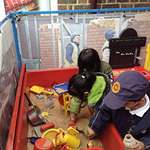 Nursery children are not allowed to play in the playground at drop-off and pick-up times, when the traffic is busiest, to protect them from car fumes. Now with a new school set to open directly opposite St Luke’s, there are concerns that pollution will increase further. ‘This will cause a lot more traffic at the beginning and end of the day,’ says Ms Hudson.
Nursery children are not allowed to play in the playground at drop-off and pick-up times, when the traffic is busiest, to protect them from car fumes. Now with a new school set to open directly opposite St Luke’s, there are concerns that pollution will increase further. ‘This will cause a lot more traffic at the beginning and end of the day,’ says Ms Hudson.
Children from further up the school delivered a letter to London Mayor Sadiq Khan earlier this year, asking him to tackle air pollution.
CASE STUDY: PRETTY WINDOWS DAY NURSERY, NOTTINGHAM
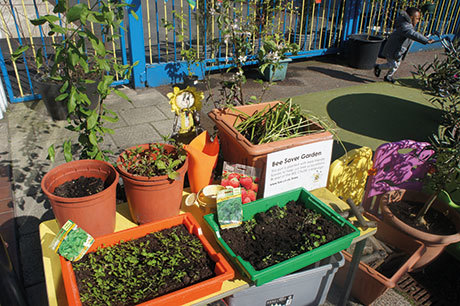
Private nursery Pretty Windows is located in a converted fruit and vegetable market in central Nottingham, which last year was identified as one of ten UK cities failing to meet World Health Organization standards for air pollution.
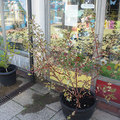 ‘When we launched 20 years ago, the air quality was measured before planning permission was granted, and it was fine, but now there is more traffic around,’ says nursery director Christine Walton.
‘When we launched 20 years ago, the air quality was measured before planning permission was granted, and it was fine, but now there is more traffic around,’ says nursery director Christine Walton.
In a conscious move to combat the pollution, the nursery has planted trees and shrubs in its outside area, and also takes children away from the site to take part in Forest School in local community gardens.
‘Many of the children do not have gardens at home,’ says Ms Walton. ‘We have someone who comes in to coach the children on football and yoga, which they do 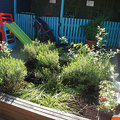 outside – we don’t want to keep them inside all the time. The plants are there to mitigate the pollution.’
outside – we don’t want to keep them inside all the time. The plants are there to mitigate the pollution.’
The planting was not cheap, but Ms Walton says it was worth it. ‘We have put in raised beds and tubs, with a wildlife section, and we grow vegetables. We also have huge planters right on the roadside with a tree in each one, and the idea is we will have apples, plums and pears this year. As the crowns of the trees get larger, they will absorb more carbon monoxide.’
The converted market as a whole is being revamped, with more green areas appearing, and Ms Walton hopes this will improve air quality. ‘Nottingham Council are taking steps to reduce pollution in the city centre as well, with trams and electric buses,’ she says.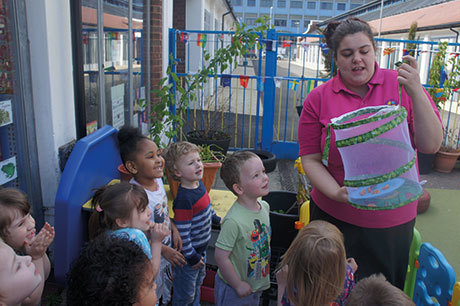
CASE STUDY: ST PHILIP’S MARSH NURSERY SCHOOL, BRISTOL
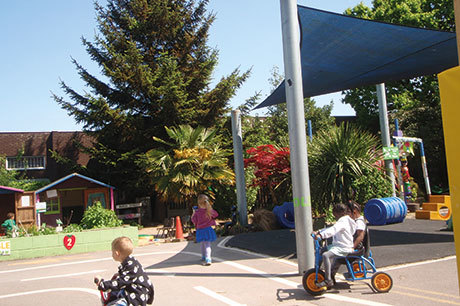
St Philip’s Marsh Nursery School is a thriving local-authority-maintained nursery school, and is part of the Barton Hill Children’s Centre. For the past two years the setting has been fighting proposals to build 48 diesel generators a mere 200m from the nursery site. The application has twice been rejected by the city council, but the company behind the generators has appealed to the Government to have the decision overturned. The nursery has organised petitions, the latest of which gained more than 100 signatures.
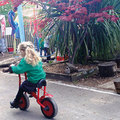 ‘I find it incredible at a time when awareness of the impact of diesel fumes on young children is hitting the headlines that anyone could think this is a good idea,’ says Simon Holmes, head teacher at the school. ‘It feels like they don’t really care about children’s health. Our nursery is already situated in an area which has the highest levels of child asthma in Bristol.’
‘I find it incredible at a time when awareness of the impact of diesel fumes on young children is hitting the headlines that anyone could think this is a good idea,’ says Simon Holmes, head teacher at the school. ‘It feels like they don’t really care about children’s health. Our nursery is already situated in an area which has the highest levels of child asthma in Bristol.’
Ironically, St Philip’s Marsh is situated in an Air Quality Management Zone, which means new developments must not add to existing levels of pollution. While the children have not been directly involved in campaigning, they do learn about looking after the environment at the nursery.
‘However, a lot of parents have been involved,’ says Mr Holmes. ‘One parent took her child to the council planning committee straight from Bristol Royal Infirmary, where she had been taken after suffering a massive asthma attack the night before, to show councillors we are talking about the impact on real children.’
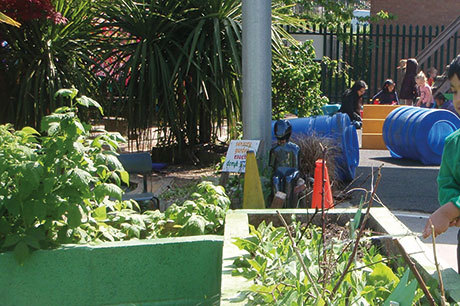
MORE INFORMATION
Consultation on the Government’s air quality plan, Improving air quality: national plan for tackling nitrogen dioxide in our towns and cities, closes on 15 June. https://consult.defra.gov.uk/airquality/air-quality-plan-for-tackling-nitrogen-dioxide
Checking pollution levels in your area: theUK-air website produces a daily air pollution forecast (https://uk-air.defra.gov.uk). You can also get air pollution updates on the @DefraUKAir Twitter feed or by calling the Defra helpline on 0800 55 66 77.
Every breath we take: the life-long impact of air pollution– a 2016 report from the Royal College of Physicians, www.rcplondon.ac.uk/projects/outputs/every-breath-we-take-lifelong-impact-air-pollution
Greenpeace’s analysis of pollution data allows you to check the NO2 reading for your road, http://energydesk.greenpeace.org/2017/04/04/air-pollution-nurseries
King’s College London (2014)‘Contribution of wood burning to PM10 in London’, Atmospheric Environment, https://kclpure.kcl.ac.uk/portal/en/publications/contribution-of-wood-burning-to-pm10-in-london(3ce54c6f-0e79-45f6-a7c6-bb71e9fd2172).html









